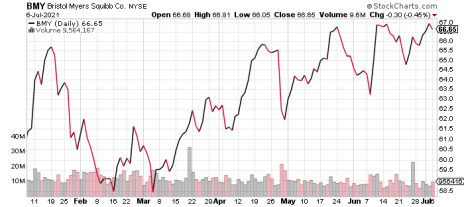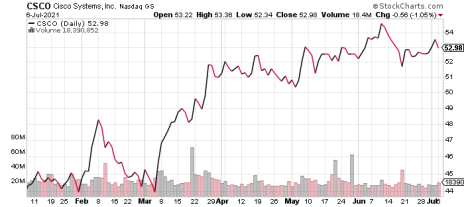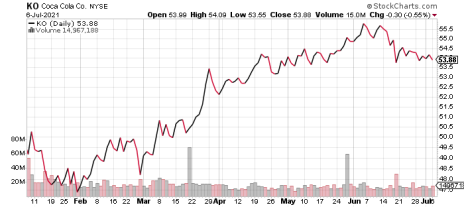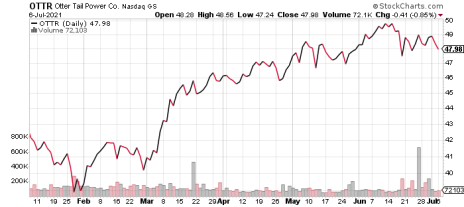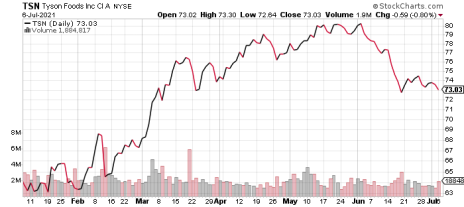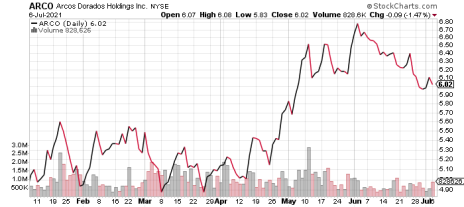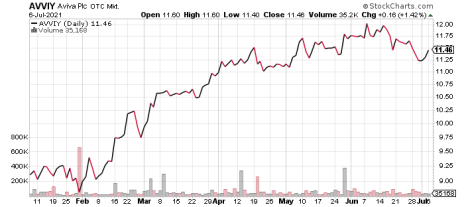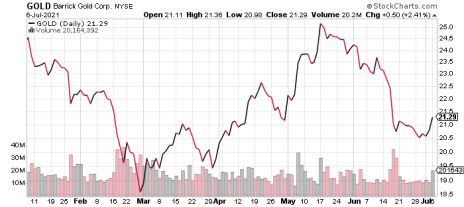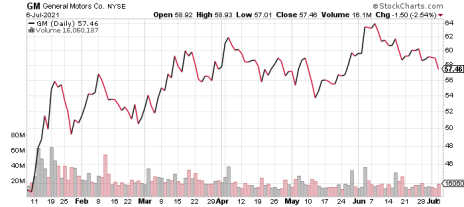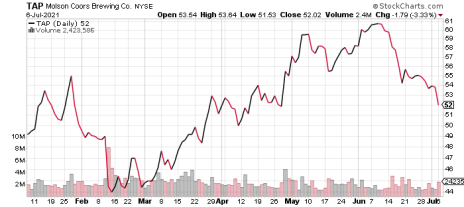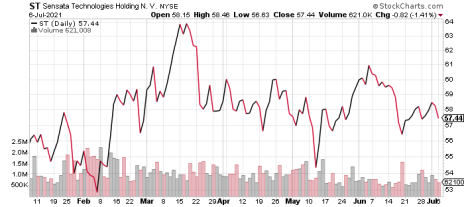Thank you for subscribing to the Cabot Undervalued Stocks Advisor. We hope you enjoy reading the July 2021 issue.
The main supports for the market (an improving economy, strengthening earnings, low interest rates and a lack of major negative surprises) remain in place. It looks like a road of green lights well into the future.
One green light has turned yellow, however, with China’s crackdown on Didi Global, owner of the country’s dominant ride-hailing app. We don’t see imminent risk for value-oriented companies, but the long-term risk is rising.
Earnings season starts next week. Earnings reports are often the primary driver of the shares of our undervalued companies. We look forward to seeing how the business fundamentals are improving and listening to managements’ commentaries and outlooks.
I’d like to invite you to our 9th Annual Cabot Investor Conference, held online again this year, on August 17-19, that’s Tuesday – Thursday. You can see presentations by all of our analysts, which will include updates on their areas of expertise and discussions of their best picks.
Please feel free to send me your questions and comments. This newsletter is written for you and the best way to get more out of the letter is to let me know what you are looking for.
I’m best reachable at Bruce@CabotWealth.com. I’ll do my best to respond as quickly as possible.
Thanks!
Cabot Undervalued Stocks Advisor 721
[premium_html_toc post_id="233390"]
A Yellow Light Appears on the Road of Green Lights
At the mid-point in the year, the investing environment seems to be exceptionally favorable. The U.S. economy is recovering robustly with promises of ongoing strength as the jobs market recovery accelerates and as international economies more fully reopen. Earnings growth for the S&P 500 this year is estimated to be 35%, followed by 21% growth in 2022. Not only are these growth rates exceptionally healthy, but analysts seem to be underestimating the strength. S&P 500 earnings estimates typically decline as a year progresses, but over the past three months, the consensus estimate for 2021 earnings of $191 has been increasing – and by a record amount (+9%).
Despite the Fed’s comments the other week, interest rates will probably remain low for at least another 18 months. And, valuations for the broad market are elevated but not extreme, at 20.4x estimated 2022 earnings of $213. Investors have remained encouraged by this exceptionally favorable environment, pushing the S&P 500 and Nasdaq to records highs.
Without any major negative surprises so far (surprises are of course unpredictable), the road ahead appears to have green lights into the foreseeable future. The market rightfully debates the course of inflation and whether growth has peaked, and is just as reasonably debating the extent to which these have been priced in. Nevertheless, this is a time for value-oriented investors to be selective and patient, as all of the green lights won’t stay green forever, and better value opportunities will eventually arrive.
With the news that the Chinese government has ordered app stores to remove ride-hailing giant Didi Global from their platforms, one green light has now turned yellow. The problem isn’t the ban, as such, (although regulatory changes that drive a days-old IPO stock down 20% is a bit concerning and probably unprecedented). The problem is that it continues the trend of China tightening its grip. Other crackdowns include those on Alibaba, Ant Group and Tesla, as well as the planned changes in Hong Kong’s data protection laws that would likely lead major western social media companies like Facebook to exit the largely mainland-China-controlled city. And, we see the trend extending toward more government control, not just for tech companies but potentially all companies doing business in China.
For value-oriented investors with little or no direct exposure to these companies, the risk of business disruption is likely minimal for several years. Unfortunately, the long-term risk is rising. Most larger U.S. companies have significant business in China, as the opportunities there are immense. Should those opportunities be curtailed, we would anticipate some pressure on domestic companies’ profits and share prices. And, in general, there is so much opportunity and so many innovative companies in China – to have to worry about unpleasant regulatory surprises is disappointing.
Fortunately, earnings season is just around the corner, with major financial companies reporting second-quarter results starting next Tuesday. Earnings reports are often the primary driver of the shares of our undervalued companies. We always look forward to seeing how the business fundamentals are improving and listening to managements’ commentaries and outlooks.
This past week was exceptionally quiet in terms of meaningful company-specific news for our recommended companies.
Share prices in the table reflect Tuesday (July 6) closing prices. Please note that prices in the discussion below are based on mid-day July 6 prices.
Note to new subscribers: You can find additional color on past earnings reports and other news on recommended companies in prior editions and weekly updates of the Cabot Undervalued Stocks Advisor on the Cabot website.
Send questions and comments to Bruce@CabotWealth.com.
Upcoming Earnings Releases
July 21: Coca-Cola (KO)
July 22: Dow (DOW)
July 27: Sensata (ST)
July 28: Bristol-Myers Squibb (BMY)
July 28: MolsonCoors Beverage Company (TAP)
July 29: Merck (MRK)
Today’s Portfolio Changes
None
Portfolio changes during the past month
Organon (OGN) – New Buy (spin-off from MRK)
Dow (DOW) – Raising price target from 70 to 78
General Motors (GM) – Raising price target from 62 to 69
MolsonCoors Beverage Company (TAP) – Raising price target from 59 to 69
Merck (MRK) – Reducing price target from 105 to 99
Tyson (TSN) – Moving from Hold to Sell
Growth & Income Portfolio
Growth & Income Portfolio stocks are generally higher-quality, larger-cap companies that have fallen out of favor. They usually have some combination of attractive earnings growth and an above-average dividend yield. Risk levels tend to be relatively moderate, with reasonable debt levels and modest share valuations.
| Stock (Symbol) | Date Added | Price Added | 7/6/21 | Capital Gain/Loss | Current Dividend Yield | Price Target | Rating |
| Bristol-Myers Squibb (BMY) | 04-01-20 | 54.82 | 66.65 | 21.6% | 2.9% | 78.00 | Strong Buy |
| Cisco Systems (CSCO) | 11-18-20 | 41.32 | 52.98 | 28.2% | 2.7% | 55.00 | Buy |
| Coca-Cola (KO) | 11-11-20 | 53.58 | 53.88 | 0.6% | 3.0% | 64.00 | Buy |
| Dow Inc (DOW) * | 04-01-19 | 53.50 | 61.93 | 15.8% | 4.5% | 78.00 | Hold |
| Merck (MRK) | 12-9-20 | 83.47 | 78.11 | -6.4% | 3.3% | 99.00 | Buy |
| Otter Tail Corporaton (OTTR) | 5-25-21 | 47.10 | 47.98 | 1.9% | 3.3% | 57.00 | Buy |
| Tyson Foods (TSN) | 12-10-19 | 88.61 | 77.70 | -12.3% | 2.3% | NA | Sell |
Notes: DOW price is based on April 1, 2019 closing price following spin-off from DWDP. The TSN price is as of the date of our Sell rating.
Bristol Myers Squibb Company (BMY) is a New York-based global biopharmaceutical company with over $45 billion in revenues. In recent years it has divested several major businesses to focus on high-value pharmaceuticals. BMY shares sell at a low absolute valuation and a sharp discount relative to peers due to worries over upcoming patent expirations for Revlimid (starting in 2022) and Opdivo and Eliquis (starting in 2026).
The shares are attractive for two reasons. First, low expectations (low valuation) minimize the downside risk should the anticipated weak fundamentals actually arrive, yet if the fundamental reality is stronger than feared the shares offer considerable upside potential.Bristol Myers Squibb Company (BMY) is a New York-based global biopharmaceutical company with over $45 billion in revenues. In recent years it has divested several major businesses to focus on high-value pharmaceuticals. BMY shares sell at a low absolute valuation and a sharp discount relative to peers due to worries over upcoming patent expirations for Revlimid (starting in 2022) and Opdivo and Eliquis (starting in 2026).
Second, Bristol is reducing its fundamental risk through a multi-pronged revenue-and-profit-replacement strategy. Bristol has a robust pipeline of internally developed treatments that offer potentially sizeable new revenues. Additionally, its acquisitions of Celgene and MyoKardia, and potentially future acquisitions, provide new growth potential that complements Bristol’s research expertise. And, Bristol has signed agreements with several generics competitors, reflecting the strong underlying demand for its “key three” products, such that the primary issue is pricing, not volumes.
All-in, it is likely that the worst-case scenario is for flat revenues over the next 3-5 years. Any indication that revenues could sustainably grow should boost BMY’s share price considerably. Helping mitigate the risk, the company is aggressively cutting its costs, including a $2.5 billion efficiency program.
Earnings for 2021 are estimated to increase 16%, although tapering to 6-8% in future years. The company is positioned, backed by management guidance, to generate between $45 billion and $50 billion in cash flow over the three years of 2021-2023. This sum is equal to 35% of the company’s $149 billion market value. The balance sheet carries $13 billion in cash and its debt is only 2x EBITDA. The first quarter 2021 report delivered mixed news, so investors will need to remain patient.
There was no significant company-specific news in the past week.
BMY shares were flat in the past week and have about 18% upside to our 78 price target. We remain patient with BMY shares.
The stock trades at a low 8.9x estimated 2021 earnings of $7.48 (up a cent from last week). On 2022 estimated earnings of $8.06 (up a cent), the shares trade at 8.2x. Either we are completely wrong about the company’s fundamental strength, or the market must eventually recognize Bristol’s earnings stability and power. We believe the earning power, low valuation and 3.0% dividend yield that is well-covered by enormous free cash flow make a compelling story. STRONG BUY
Cisco Systems (CSCO) produces technology equipment (72% of revenues) that connects and manages data and communications networks, and also sells application software, security software and related services. As customers gradually migrate to cloud computing, Cisco’s equipment, and thus its one-stop-shop capabilities, are slowly becoming less valuable, leading to stagnant revenue growth and weak stock performance. To help restore growth, Cisco is shifting toward a software and subscription model and ramping new products, helped by its strong reputation and its entrenched position within its customers’ infrastructure. Cisco’s prospects are starting to improve under CEO Chuck Robbins (since 2015). The company is highly profitable, generates vast cash flow (which it returns to shareholders through dividends and buybacks) and has a very strong balance sheet.
There was no significant company-specific news in the past week.
CSCO shares fell 1% in the past week and have about 5% upside to our 55 price target. While we generally would move the shares to a Hold, we believe Cisco’s earnings potential is higher than currently estimated, which leaves additional potential upside.
The shares trade at 16.4x estimated FY2021 earnings of $3.21 (unchanged in the past week). On FY2022 earnings (which ends in July 2022) of $3.42 (unchanged), the shares trade at 15.4x. On an EV/EBITDA basis on FY2021 estimates, the shares trade at a discounted 11.7x multiple. CSCO shares offer a 2.8% dividend yield. We continue to like Cisco. BUY
Coca-Cola (KO) is best-known for its iconic soft drinks but nearly 40% of its revenues come from non-soda brands across the non-alcoholic spectrum, including PowerAde, Fuze Tea, Glaceau, Dasani, Minute Maid and Schweppes. Its vast global distribution system offers it the capability of reaching essentially every human on the planet.
Coca-Cola’s longer-term picture looks bright, despite the clouded near-term outlook due to the pandemic and the secular trend away from sugary sodas, its high exposure to foreign currencies and always-aggressive competition. Another overhang is the tax dispute that could cost as much as $12 billion – we don’t see an immediate resolution but consider $12 billion to be a worst-case scenario.
Relatively new CEO James Quincey (2017) is reinvigorating the company by narrowing its oversized brand portfolio, boosting its innovation and improving its efficiency. The company is also working to improve its image (and reality) of selling sugar-intensive beverages that are packaged in environmentally-insensitive plastic. Coca-Cola is supported by a sturdy balance sheet. Its growth investing, debt service and $0.42/share quarterly dividend are well-covered by free cash flow.
There was no significant company-specific news in the past week.
KO shares were flat in the past week and have about 19% upside to our 64 price target.
While the valuation is not statistically cheap, at 24.6x estimated 2021 earnings of $2.18 (unchanged in the past week) and 22.8x estimated 2022 earnings of $2.36 (unchanged), the shares remain undervalued given the company’s future earning power and valuable franchise. Also, the value of Coke’s partial ownership of a number of publicly traded companies (including Monster Beverage) is somewhat hidden on the balance sheet, yet is worth about $23 billion, or 9% of Coke’s market value. This $5/share value provides additional cushion supporting our 64 price target. KO shares offer an attractive 3.1% dividend yield. BUY
Dow Inc. (DOW) merged with DuPont in 2017 to temporarily create DowDuPont, then split into three companies in 2019 based roughly along product lines. The new Dow is the world’s largest producer of ethylene/polyethylene, the most widely used plastics. Dow is primarily a cash-flow story driven by three forces: 1) petrochemical prices, which are often correlated with oil prices and global growth, along with competitors’ production volumes; 2) volume sold, largely driven by global economic conditions, and 3) ongoing efficiency improvements (a never-ending quest of all commodity companies to maintain their margins).
Dow continues to participate in the economic recovery. For 2021, analysts estimate revenue growth to be 25%, aided by higher prices and volumes. The strong U.S. dollar may be a modest headwind as it makes revenues produced in other currencies less valuable.
Two key questions for the Dow story: how much better can fundamentals get, and what will the company do with its vast free cash flow? Our view on the first: conditions are remarkably strong now yet are likely to improve as domestic and global industrial and consumer goods production continues to rebound. This may last at least a few quarters, perhaps longer, before capacity increases across the industry signal a cyclical peak.
On the second, Dow is committed to the dividend and to debt and pension obligation reductions, with modest repurchase shares to cover dilution from stock options, while also keeping the constraints on its capital spending above its maintenance level.
There was no significant company-specific news in the past week.
Dow shares slipped 2% this past week and have 26% upside to our recently increased 78 price target.
The shares trade at 11.6x estimated 2022 earnings of $5.32 (unchanged this past week). The estimate for 2021 earnings was unchanged. Analysts are somewhat pessimistic about 2022 earnings matching 2021 earnings (they assume a 20% decline). If the 2022 estimate continues to tick up, the shares will likely follow, although Dow’s cyclical earnings and investor fears of an eventual downcycle will ultimately limit Dow’s upside. The high 4.5% dividend yield adds to the shares’ appeal. HOLD
Merck (MRK) – Pharmaceutical maker Merck focuses on oncology, vaccines, antibiotics and animal health. The shares sell at a significant discount to its peers, as Keytruda, a blockbuster oncology treatment representing about 30% of total revenues, will face generic competition in late 2028. Also, hanging over the stock is possible generic competition for its Januvia diabetes treatment starting in 2022, and the possibility of government price controls.
Keytruda remains an impressive franchise that is growing at a 20+% annual rate. The company is becoming more aggressive about replacing the potentially lost revenues, even though it has nearly seven years to accomplish this. The new CEO, previously the CFO, will likely accelerate Merck’s acquisition program, which adds both risk and return potential to the Merck story.
The company spun off its Organon business on June 2nd. Longer term, we see Merck spinning out or selling its animal health business. Merck is highly profitable and has a solid balance sheet with $9 billion of fresh cash from its Organon dividend. The low valuation, strong balance sheet and sturdy cash flows provide real value. The attractive 3.3% dividend yield pays investors to wait.
Post-spin-off, Merck’s revenues will have faster growth. Its profit margins will initially decline, but should fully recover, plus some, helped by the gradual elimination of redundant Organon stranded costs. We reduced our Merck price target by $6/share, from 105 to 99, to reflect the spin-off and to incorporate a slightly more conservative valuation multiple.
There was no significant company-specific news in the past week.
Merck shares rose 1% this past week as the after-spin-off glow continues. The shares have about 27% upside to our 99 price target.
Valuation is an attractive 13.3x this year’s estimated earnings of $5.87 (down fractionally in the past week). Merck produces generous free cash flow to fund its current dividend as well as likely future dividend increases, although its shift to a more acquisition-driven strategy will slow the pace of increases. BUY
Otter Tail Corporation (OTTR) – Based in northwest Minnesota, this $2 billion market cap company is a rare combination of an electric utility and a manufacturing business. Otter Tail’s power operations have a solid and high-quality franchise, with a balanced mix of generation, transmission and distribution assets that produce about 75% of the parent company’s earnings. An accommodative regulatory environment is allowing the utility to continue to add capacity, although its projected rate base growth is likely to be incrementally slower than in prior years.
The manufacturing side includes four well-managed specialized metals and plastics companies. Here, stronger end-market growth should more than offset rising input prices.
Otter Tail’s sturdy balance sheet is investment grade, earnings and cash flow are growing and the company prides itself on steady dividend growth. The unusual utility/manufacturing structure might make the company a target for activists, as the two parts may be worth more separately, perhaps in the hands of larger, specialized companies.
There was no significant company-specific news in the past week.
OTTR shares fell 2% in the past week and have about 20% upside to our 57 price target. The stock trades at about 18.2x estimated 2021 earnings of $2.61 (unchanged this past week) and offer an attractive 3.3% dividend yield. BUY
Tyson Foods (TSN) is one of the world’s largest food companies, with nearly $43 billion in revenue. We recently moved TSN shares from Hold to Sell. The stock essentially reached our 82 price target. We see little justification in raising our price target, particularly given the revolving door leadership problem. The valuation is reasonable, but not interesting enough. The shares produced an 12% loss since our initial recommendation in December 2019, but have gained 32% from June 30, 2020 when the chief analyst position changed over. SELL
Buy Low Opportunities Portfolio
Buy Low Opportunities Portfolio stocks include a wide range of value opportunities, often with considerable upside. This group may include stocks across the quality and market cap spectrum, including those with relatively high levels of debt and a less-clear earnings outlook. The stocks may not pay a dividend. In all cases, the shares will trade at meaningful discounts to our estimate of fair value.
| Stock (Symbol) | Date Added | Price Added | 7/6/21 | Capital Gain/Loss | Current Dividend Yield | Price Target | Rating |
| Arcos Dorados (ARCO) | 04-28-21 | 5.41 | 6.02 | 11.3% | 0.0% | 7.50 | Buy |
| Aviva (AVVIY) | 03-03-21 | 10.75 | 11.48 | 6.8% | 5.1% | 14.00 | Buy |
| Barrick Gold (GOLD) | 03-17-21 | 21.13 | 21.29 | 0.8% | 1.7% | 27.00 | Buy |
| General Motors (GM) | 12-31-19 | 36.60 | 57.46 | 57.0% | — | 69.00 | Hold |
| Molson Coors (TAP) | 08-05-20 | 36.53 | 52.02 | 42.4% | — | 69.00 | Buy |
| Organon (OGN) | 06-07-21 | 31.42 | 31.00 | -1.3% | — | 46.00 | Buy |
| Sensata Technologies (ST) | 02-17-21 | 58.57 | 57.44 | -1.9% | — | 75.00 | Buy |
Arcos Dorados (ARCO) – Spanish for “golden arches,” Arcos Dorados is the world’s largest independent McDonald’s franchisee, operating over 2,200 restaurants and holding exclusive rights in 20 Latin American and Caribbean countries. Based in stable Uruguay and listed on the NYSE, the company produces about 72% of its revenues in Brazil, Mexico, Argentina and Chile. Arcos’ leadership looks highly capable, led by the founder/chairman who owns a 38% stake.
The pandemic has weighed on revenues, while the Venezuelan economic mess, political/social unrest, inflation and currency devaluations in other countries create profit headwinds and investor angst. The company is well managed and positioned to benefit as local economies reopen. Debt is reasonable relative to post-recovery earnings, and the company is currently producing positive free cash flow, which buy it time until the recovery arrives.
The company announced that on July 23, it will distribute a stock dividend of one share for every 70 shares held. This is in essence a fractional split which will increase the share count by 1.4%, but as shareholders will receive no increase in value it has little significance. Arcos last paid a cash dividend in December 2020, at 3 cents a share. We would like to see the company return to paying a cash dividend.
ARCO shares fell 2% this past week and have about 28% upside to our 7.50 price target. The stock trades at 18.9x estimated 2022 earnings per share of $0.31 (up a cent from a week ago). BUY
Aviva, plc (AVVIY) – Based in London, England, Aviva is a major European insurance company specializing in life insurance, savings and investment management products. Long a mediocre company, the frustrated board last July installed Amanda Blanc as the new CEO, with the task of fixing the business. She is aggressively re-focusing the company on its core geographic markets (UK, Ireland, Canada). The turnaround also includes improving Aviva’s product competitiveness, rebuilding its financial strength and trimming its bloated costs. The new leadership reduced the company’s recurring dividend, but to a more predictable and sustainable level, along with what is likely to be a modest but upward trajectory.
Aviva’s surplus cash flow, partly from divestitures, will be directed toward debt reduction and the recurring dividend. As it is over-capitalized, Aviva will pay out potentially sizeable special dividends to shareholders.
The company’s first quarter trading update (sales and capital strength only, no profit update) was encouraging, yet more improvement is needed. Capital strength continues to improve, even as the company set aside funds for dividends and repaid some of its debt. With its ambitious global divestiture program now completed, Aviva can now fully concentrate on improving the performance of its remaining core businesses.
There was no significant company-specific news in the past week.
Aviva shares rose 1% this past week and have about 22% upside to our 14 price target. The stock trades at 7.5x estimated 2021 earnings per ADS of $1.52 (unchanged) and at about 97% of tangible book value. AVVIY shares offer an attractive and likely solid and recurring 5.1% dividend yield. BUY
Barrick Gold (GOLD) – Toronto-based Barrick is one of the world’s largest and highest-quality gold mining companies. About 50% of its production comes from North America, with 32% from Africa/Middle East and 18% from Latin America/Asia Pacific. Our thesis is based on two points. First, that Barrick will continue to improve its operating performance (led by its new and highly capable CEO), continue to generate strong free cash flow at current gold prices, and return much of that free cash flow to investors while making minor but sensible acquisitions. Second, Barrick shares offer optionality – if the enormous fiscal stimulus, rising taxes and heavy central bank bond-buying produces stagflation and low interest rates, then the price of gold will move upward and lift Barrick’s shares with it. Given their attractive valuation, the shares don’t need this second (optionality) point to work – it offers extra upside.
Major risks include the possibility of a decline in gold prices, production problems at its mines, a major acquisition and/or an expropriation of one or more of its mines.
There was no significant company-specific news in the past week.
Barrick shares rose 3% this past week and have about 28% upside to our 27 price target. Sentiment on the company and the price of gold appears to be bottoming out. The price target is based on 7.5x estimated 2021 EBITDA and a modest premium to its $25/share net asset value. Commodity gold rose about 2% to $1,792/ounce.
On its recurring $.09/quarter dividend, GOLD shares offer a reasonable 1.7% dividend yield. Barrick will pay an additional $0.42/share in special distributions this year, lifting the effective dividend yield to 3.7%. BUY
General Motors (GM) – GM is making immense progress with its years-long turnaround from a poorly-managed post-bankruptcy car maker to a highly profitable gas and electric vehicle producer. We would say it is perhaps 85% of the way through its gas-powered vehicle turnaround and is well positioned but in the early stages of its EV development. GM Financial will likely continue to be a sizeable profit generator. GM is fully charged for both today’s environment and the EV world of the future, although much of its value is based on the unknown EV future.
GM announced that it is investing in a geothermal project in California to provide a source of lithium for its EV batteries. Second quarter U.S. light vehicle sales matched the second quarter 2019 volume (the last year prior to the pandemic). GM and Toyota tied for the #1 spot, as GM was hurt by the chip shortage while Toyota’s chip stockpile helped its volumes. Average prices surged, due to limited supply, high demand and high used-car prices.
GM shares fell 2% this past week and have 20% upside to our recently raised 69 price target.
On a P/E basis, the shares trade at 8.4x estimated calendar 2022 earnings of $6.87 (unchanged this past week). The 2021 estimate rose about 1%. The P/E multiple is helpful, but not a precise measure of GM’s value, as it has numerous valuable assets that generate no earnings (like its Cruise unit, which is developing self-driving cars and produces a loss), its nascent battery operations, and its other businesses with a complex reporting structure, nor does it factor in GM’s high but un-earning cash balance which offsets its interest-bearing debt. However, it is useful as a rule-of-thumb metric, and provides some indication of the direction of earnings estimates, and so we will continue its use here. HOLD
Molson Coors Beverage Company (TAP) – The thesis for this company is straight-forward – a reasonably stable company whose shares sell at an overly discounted price. One of the world’s largest beverage companies, Molson Coors produces the highly recognized Coors, Molson, Miller and Blue Moon brands as well as numerous local, craft and specialty beers. About two-thirds of its $10 billion in net revenues are produced in the United States, where it holds a 24% share of the beer market.
Investors’ primary worry about Molson Coors is its lack of meaningful (or any) revenue growth as it produces relatively few of the fast-growing hard seltzers and other trendier beverages. Our view is that the company’s revenues are resilient, it produces generous cash flow and is reducing its debt – traits that are value-accretive and underpriced by the market. A new CEO is helping improve its operating efficiency and expand carefully into more growthier products.
Molson is estimated to produce about 5% revenue growth and a 1% decline in per share earnings in 2021. Profit growth is projected to increase to a 6-8% rate in future years. Weakness this year is closely related to the sluggish reopening of the European economies, along with higher commodity and marketing costs. The company will likely re-instate its dividend later this year, which could provide a 2.7% yield.
There was no significant company-specific news in the past week.
TAP shares fell 5% in the past week and have about 34% upside to our 69 price target. The shares trade at 13.3x estimated 2021 earnings of $3.89 (down a cent this past week). Estimates for 2022 were unchanged.
On an EV/EBITDA basis, or enterprise value/cash operating profits, the shares trade for about 9.3x current year estimates, still among the lowest valuations in the consumer staples group and below other brewing companies. BUY
Organon & Company (OGN) was spun-off from Merck in June 2021. MRK holders received one OGN share for every 10 MRK shares held.
We did additional research into Organon, and like the story even more. We recently selected it as a Cabot Turnaround Letter featured recommendation with a 46 price target. Below is the write-up, in full. The differences in valuation reflect share price movements:
Organon & Company (OGN) is a United States-based global pharmaceutical company with sales of $6.3 billion. About 80% of its sales are produced outside of the United States. Founded in the Netherlands in 1923, the business merged into Akzo Nobel in 1969, was acquired by Schering-Plough in 2007, then joined Merck when it acquired Schering-Plough in 2009. In June 2021, 100% of Organon’s shares were spun-off from Merck. Organon is a member of the S&P 500.
The company has three segments. Established Brands (68% of revenues) is a collection of nearly 50 mostly off-patent cardiovascular, respiratory and other therapies. Women’s Health (23%) includes contraceptives and fertility products. The Biosimilars segment (9%) includes five approved treatments for autoimmune, arthritis and other diseases through a joint venture with Samsung Bioepis. Biosimilars are FDA-approved alternatives to patented biological drugs, which, unlike chemical pharmaceuticals, are created from living cells.
Shares of Organon have fallen sharply since their debut at around 38. One reason is technical: many Merck shareholders likely have little interest in holding a small pharmaceutical company facing patent erosion risks, and thus have sold their shares regardless of price. More fundamentally, investors worry about patent-related revenue erosion in the Established Brands segment and the 2025-2027 patent expiration for its Nexplanon women’s health product (11% of total sales). Also, revenues from the Chinese hospital channel may continue to be pressured by government buying programs. The market sees many years of 3-4% revenue decay at best, amid fears of a sharper decline, for Organon.
While acknowledging the revenue risks, we have a more optimistic view of Organon’s future. The marquee Nexplanon product is a highly valuable franchise, with solid 10% growth potential for years. There is a strong possibility that it can extend its patent to as late as 2030. Its complex production process could easily ward off generic competitors afterwards. And, as it is implanted under the skin, women may be hesitant to opt for a discount version. Organon’s fertility treatments are well positioned to grow, particularly in China. The Biosimilars segment offers double-digit growth potential: the industry is in its early innings, Organon has a solid portfolio, and the company has plans for new launches every 1-2 years, including a Humira biosimilar this year in international markets.
While revenue losses in the Established Brands are inevitable, most of the risks are behind it, as only $250 million in revenues, or about 6% of total company revenues, face patent expiration over the next four years. And, the highly diversified product roster minimizes the impact from any single treatment or country. Similarly, much of the pricing pressure from China’s Volume Based Procurement (VBP) program has been absorbed, as about 80% of the company’s portfolio will have full exposure to VBP by the end of this year. And, 40% of the company’s China revenues are produced through the retail channel, which is growing quickly and isn’t as vulnerable to VBP pressures.
Organon’s management team has deep leadership, operating and financial experience. The CEO, Kevin Ali, led Merck’s international business. The CFO previously was Allergan’s and Catalent’s chief financial officer. Other senior executives and the board of directors, bring valuable capabilities, as well. Given that the company’s products were neglected within Merck’s enormous operations, there are plenty of opportunities for this management team to rejuvenate Organon’s business.
Strategically, we see the company making smart yet modest-sized acquisitions to expand its Women’s Health business, as this is its primary focus. We would not be entirely surprised if Organon divested its Established Brands segment in a few years, as discarding this perceived albatross would be a significant share price booster.
The company’s robust $1.3 billion in annual free cash flow is more than adequate to trim the modestly elevated $9.5 billion in debt (which funded a $9 billion dividend back to Merck) while also supporting the acquisition program.
Like all turnarounds, OGN shares carry risk. Yet, the shares’ discounted valuation, at 7.2x estimated 2021 EBITDA and 4.6x estimated 2021 earnings, more than adequately reflects this. With improved revenue visibility (we model only 2% cumulative 3-year growth), incrementally wider margins from better oversight, plus the value of interim free cash flows, the shares have considerable upside potential. Additionally, Organon will likely pay out about 20% of its free cash flow in dividends, providing what we estimate will be a 2.7% yield.
There was no significant company-specific news in the past week.
OGN shares were flat in the past week and have about 51% upside to our new 46 price target (using the same target as the Cabot Turnaround Letter).
The shares trade at 4.9x estimated 2021 earnings of $6.25 and 5.0x estimated 2022 earnings of $6.08. These are remarkably low valuations. Estimates are starting to converge around these numbers. Notably, analysts are pessimistic about 2022 earnings, as they project a 3% year/year decline.
On an EV/EBITDA basis, or enterprise value/cash operating profits, the shares trade for about 7.2x current year estimates, also quite low. BUY
Sensata Technologies (ST) is a $3.8 billion (revenues) producer of an exceptionally broad range (47,000 unique products) of highly engineered sensors used by automotive, heavy vehicle, industrial and aerospace customers. These products are typically critical components within cars, trucks, factories and jets, yet since they represent a tiny percentage of the end-products’ total cost, they generally yield high profit margins. Also, as their reliability is vital to safely and performance, customers are reluctant to switch to another supplier that may have lower prices but also lower or unproven quality. Sensata’s franchise provides it with a durable source of core revenues and profits.
Sensata is a truly global company. Nearly two-thirds of its revenues are generated outside of the United States, with China producing about 21%.
The company was founded in 1916, owned by Texas Instruments for decades, and returned to public ownership in 2010. Sensata’s foundation has long been as a Tier One supplier to automakers, which still provide about 60% of total revenues. Its innovations have helped increase its content per vehicle such that its automotive revenues are outgrowing the industry – in the most recent quarter by 9.1 percentage points. Sensata also benefits from rising secular demand for improved fuel efficiency, safety, emissions and customer conveniences like lane-keeping and other advanced driver-assist systems. As the light vehicle market is thriving, Sensata’s core business should ride along at a healthy clip. Its heavy vehicle/off-road segment (about 17% of sales) is also seeing strong growth, helped by the early stages of a cyclical rebound.
Since gaining its independence, Sensata has pursued new opportunities in adjacent markets. Called “megatrends” by the company, which include electric vehicles, autonomy and smart connected, these new markets offer considerable growth potential. Its Xirgo deal opens a new market in telematics and data insight for freight truck and cargo/container fleets. The Gigavac and Lithium Battery acquisitions build upon Sensata’s growing presence in the electric vehicle battery industry. Once a threat, electric vehicles are now an opportunity, as the company’s expanded product offering allows it to sell more content into an EV than it can into an internal combustion engine vehicle.
Revenues this year are projected to increase by about 24%, driven by a cyclical rebound, then taper to a 6% rate in future years. Despite the apparent strength, this year’s results are being constrained by the semiconductor shortage. Expected profit growth of 54% in 2021, also boosted by the recovery, is estimated to taper to about 10-20% in future years.
Sensata’s balance sheet is strong. Its $4 billion in debt is partly offset by nearly $2 billion in cash, with its net debt at only 2x EBITDA (a measure of cash operating earnings). This is arguably too conservative given the company’s franchise and wide 20%+ operating profit margin. Healthy free cash flow provides the company with considerable financial flexibility. Sensata’s relatively new CEO, Jeff Cote, who was promoted in March 2020, will likely devote some of its financial resources to additional acquisitions to continue to expand the company’s growth potential.
Risks include a possible automotive cycle slowdown, chip supply issues, geopolitical issues with China, currency and over-paying/weak integration related to its acquisitions.
There was no significant company-specific news in the past week.
ST shares fell 1% this past week and have about 31% upside to our 75 price target.
The stock trades at 14.1x estimated 2022 earnings of $4.04 (unchanged this past week). On an EV/EBITDA basis, ST trades at 11.1x estimated 2022 EBITDA. BUY
Disclosure: The chief analyst of the Cabot Undervalued Stocks Advisor personally holds shares of every recommended security, except for “New Buy” recommendations. The chief analyst may purchase or sell recommended securities but not before the fourth day after any changes in recommendation ratings has been emailed to subscribers. “New Buy” recommendations will be purchased by the chief analyst as soon as practical following the fourth day after the newsletter issue has been emailed to subscribers.
Strong Buy – This stock offers an unusually favorable risk/reward trade-off, often one that has been rated as a Buy yet the market has sold aggressively for temporary reasons. We recommend adding to existing positions.
Buy – This stock is worth buying.
Hold – The shares are worth keeping but the risk/return trade-off is not favorable enough for more buying nor unfavorable enough to warrant selling.
Retired – This stock has been removed from the portfolio, primarily for being fully valued. We generally view the company as fundamentally solid with few problems. Investors may choose to hold these shares to minimize portfolio turnover, seek to capture continued upward share price momentum, or other reasons.
Sell – This stock is approaching or has reached our price target, its value has become permanently impaired or changes in its risk or other traits warrant a sale.
The next Cabot Undervalued Stocks Advisor issue will be published on August 4, 2021.
Cabot Wealth Network
Publishing independent investment advice since 1970.
President & CEO: Ed Coburn
Chief Investment Strategist: Timothy Lutts
Cabot Heritage Corporation, doing business as Cabot Wealth Network
176 North Street, PO Box 2049, Salem, MA 01970 USA
800-326-8826 | support@cabotwealth.com | CabotWealth.com
Copyright © 2021. All rights reserved. Copying or electronic transmission of this information without permission is a violation of copyright law. For the protection of our subscribers, copyright violations will result in immediate termination of all subscriptions without refund. Disclosures: Cabot Wealth Network exists to serve you, our readers. We derive 100% of our revenue, or close to it, from selling subscriptions to our publications. Neither Cabot Wealth Network nor our employees are compensated in any way by the companies whose stocks we recommend or providers of associated financial services. Employees of Cabot Wealth Network may own some of the stocks recommended by our advisory services. Disclaimer: Sources of information are believed to be reliable but they are not guaranteed to be complete or error-free. Recommendations, opinions or suggestions are given with the understanding that subscribers acting on information assume all risks involved. Buy/Sell Recommendations: are made in regular issues, updates, or alerts by email and on the private subscriber website.
Subscribers agree to adhere to all terms and conditions which can be found on CabotWealth.com and are subject to change. Violations will result in termination of all subscriptions without refund in addition to any civil and criminal penalties available under the law.

